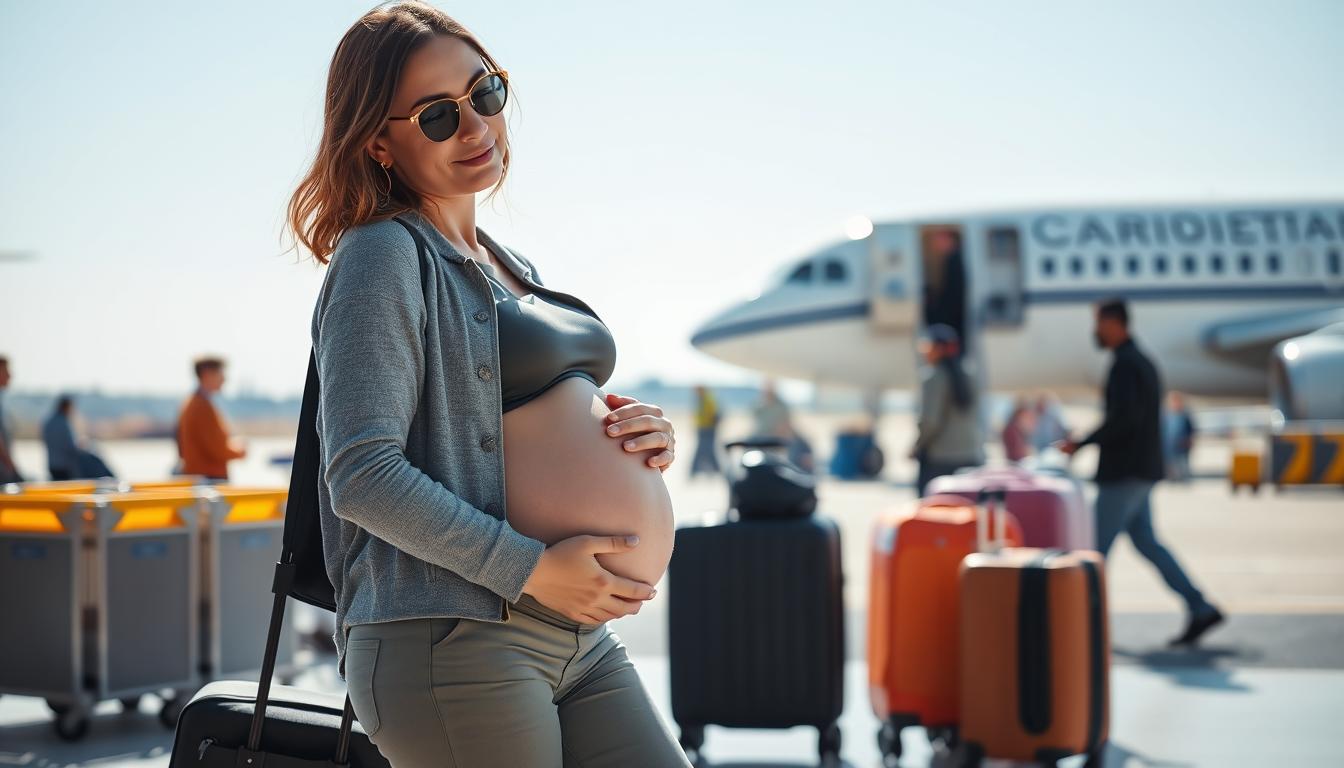Air travel while pregnant can be safe and comfy with the right steps. Many expectant moms wonder about flying during pregnancy. This guide gives key tips for a smooth journey for mom and baby.
Dr. Cassandra Simmons of NewYork-Presbyterian Westchester says the safest time to fly is in the second trimester. This is from 14 to 28 weeks. It’s when most women have less trouble and more energy.
When planning your trip, remember most airlines let pregnant women fly up to 36 weeks for domestic flights. For international trips, it’s usually earlier, between 28 to 35 weeks. Always check with your airline and doctor before booking.
Key Takeaways
- Second trimester (14-28 weeks) is generally the safest for air travel
- Most airlines allow flying up to 36 weeks for domestic flights
- International travel is typically restricted after 28-35 weeks
- Consult your healthcare provider before flying
- Stay within a 300-mile radius of home during the third trimester
- Consider potential risks like radiation exposure for frequent flyers
- Plan for emergencies and research medical facilities at your destination
Understanding Air Travel Safety During Pregnancy
Air travel safety is very important for pregnant women on planes. They need to plan carefully and follow certain rules. We will look at the safety tips, airline rules, and health needs for flying when pregnant.
Safety Considerations by Trimester
The second trimester is usually the safest for flying. Most doctors say it’s okay to fly before 36 weeks if there are no health issues. But, the risk changes with each trimester:
- First Trimester: Higher risk of pregnancy emergencies
- Second Trimester: Lowest risk period
- Third Trimester: Increased risk of complications and early labor
Airline Policies and Restrictions
Airlines have their own rules for pregnant travelers:
| Stage of Pregnancy | Domestic Flights | International Flights |
|---|---|---|
| Before 28 weeks | Usually allowed | Usually allowed |
| 28-35 weeks | Allowed with restrictions | May be restricted |
| After 36 weeks | Often not allowed | Not allowed |
Medical Clearance Requirements
Many airlines ask for a doctor’s note for pregnant passengers, especially later on. This can include:
- Proof of due date
- Letter from healthcare provider
- Medical certificate stating fitness to fly
Remember, safety in the air is more than just following airline rules. Be aware of risks like blood clots and radiation. Always talk to your doctor before flying when you’re pregnant.
Best Time to Fly During Pregnancy
When you’re pregnant, flying needs careful planning. The best time is usually between weeks 14 and 27. This is when morning sickness often goes away, and you’re not yet too uncomfortable.
Airlines let you fly in the US until about 36 weeks. But, international flights might have different rules. Always check with your airline.
For example, Air New Zealand lets you fly up to 40 weeks for short flights. But, Emirates and Singapore Airlines need a doctor’s okay after 36 weeks.
The American College of Obstetrics and Gynecology says flying is safe until 36 weeks if you and your baby are healthy. Here are some tips for flying while pregnant:
- Book an aisle seat for easier movement
- Wear compression socks to prevent deep vein thrombosis
- Stay hydrated throughout the flight
- Carry medical records and insurance information
After 28 weeks, many airlines need a doctor’s note. This note should say you’re okay to fly. Always talk to your doctor before flying, as your situation might be different.
Travelling During Pregnancy by Flight: Essential Preparations
Planning a flight while pregnant needs careful thought. You must follow aviation guidelines for expectant mothers. This ensures a safe and comfy journey for you and your baby.
Pre-flight Medical Consultation
See your doctor before booking your flight. They will check if you can fly safely. They’ll also give advice based on your pregnancy and health.

Documentation Requirements
Airlines need certain papers from pregnant travelers. Get ready with:
- A doctor’s note saying you can fly
- Your prenatal records
- Updated vaccination records
Insurance Coverage Considerations
Check your travel insurance policy. Make sure it covers pregnancy issues. You might need extra coverage for medical evacuations abroad.
| Trimester | Medical Clearance | Insurance Recommendations |
|---|---|---|
| First | Usually not required | Standard travel insurance |
| Second | May be required after 28 weeks | Pregnancy-specific coverage |
| Third | Required, with restrictions after 36 weeks | High-risk pregnancy coverage |
By following these guidelines, you’ll be ready for a safe and comfy flight during your pregnancy.
Health Risks and Preventive Measures
Pregnant women face special health risks when flying. It’s important to know these risks and how to stay safe. We’ll look at the main concerns and how to handle them, keeping airline policies in mind.
Deep Vein Thrombosis Prevention
Pregnant women are more likely to get deep vein thrombosis (DVT) when flying. To lower this risk, wear compression stockings and get up often. Many airlines suggest these steps for pregnant women.
Radiation Exposure Concerns
Flying means more cosmic radiation exposure. Though the risk is small, pregnant women should fly less. Some airline policies for pregnant women say no flying after 36 weeks to cut down on radiation.
Altitude-Related Issues
Changes in air pressure can affect pregnant women. Drink lots of water and avoid foods that make gas before and during the flight. Most airlines advise these steps to avoid discomfort.
Always talk to your doctor before flying. They can check your risk and give advice just for you. Make sure to check the airline’s policies for pregnant women before booking. This way, your flight will be safe and smooth.
| Trimester | Flight Risk Level | Recommended Precautions |
|---|---|---|
| First | Low | Stay hydrated, move regularly |
| Second | Moderate | Wear compression stockings, limit flight duration |
| Third | High | Consult doctor, check airline policies, consider postponing travel |
Comfort and Safety During Flight
Flying when you’re pregnant needs extra care for comfort and safety. Maternity flight rules say it’s key to use the seat belt right. Place the lap belt under your belly and the diagonal strap between your breasts for the best protection.
Drinking water is important to avoid getting dehydrated. Wear clothes that are loose and comfy. Avoid tight clothes that might cut off your blood flow.
For long flights, here are some tips:
- Take walks up and down the aisle to keep blood flowing
- Do exercises while sitting to stop blood clots
- Use a neck pillow for extra comfort
- Bring healthy snacks to keep your energy up
Avoid eating foods that make you gassy before and during the flight. If you get sick to your stomach, bring ginger candies or crackers to help.
Most airlines don’t let pregnant women fly after 36 weeks. If you’re carrying twins or have health issues, talk to your doctor first. By following these tips, you can have a safer and more comfy flight.
Managing Medical Emergencies While Flying
It’s important for pregnant women to know how to handle medical emergencies in the air. They should be ready for unexpected situations at high altitudes.

Emergency Contact Information
Pregnant travelers should make a list of emergency contacts before flying. Include your doctor’s number, travel insurance, and a family member you trust. Having this list ready can save time in an emergency.
Location of Medical Facilities
It’s wise to know where medical facilities are at your departure and arrival airports. Many airports have clinics or hospitals nearby. Look up these places before you fly to get help fast if needed.
Communication with Flight Staff
Telling flight attendants you’re pregnant is a safety step. They can help more and know how to handle medical issues. If there’s an emergency, they can get help from the ground quickly.
| Aircraft Size | Required First Aid Kits |
|---|---|
| Under 50 seats | 1 |
| 51-150 seats | 2 |
| 151-250 seats | 3 |
| 251+ seats | 4 |
Remember, planes in the USA have emergency medical kits. These kits, along with the crew, offer safety for pregnant women during their flights.
International Travel Considerations for Pregnant Women
Planning a trip abroad when you’re pregnant needs careful thought. Knowing how to fly safely during pregnancy is key. The American College of Obstetricians and Gynecologists says the second trimester is safest for flying.
Airlines let pregnant women fly up to 36 weeks for domestic trips. But for international flights, it’s often earlier, from 28 to 35 weeks. Always check the airline’s rules before booking.
Vaccines are important for traveling abroad. Pregnant women might need to avoid some countries’ vaccines. This is especially true if you’ve had miscarriages or heart issues.
- Avoid high-altitude destinations
- Steer clear of areas with malaria or life-threatening infection outbreaks
- Check if live-virus vaccines are needed for your destination
Travel insurance is a must for trips abroad when pregnant. Look for policies that cover pregnancy-related issues and medical care abroad. Remember, healthcare costs and standards vary by country.
Lastly, think about radiation exposure on long flights. While it’s usually safe, frequent flyers might get too much radiation. Talk to your doctor before your trip.
Essential Items to Pack for Air Travel
When you’re flying while pregnant, it’s key to pack right. A good bag means you’re ready for a comfy and safe trip.
Medical Documentation
Don’t forget your medical records and a doctor’s note saying it’s okay to fly. These are important for any flight surprises.
Comfort Items
Bring things that make flying easier. A pregnancy pillow like the Oternal, at $40 on Amazon, is great. For your neck, try the Cabeau Evolution Cool neck pillow, which costs $60.
Emergency Supplies
Have these items ready for anything:
- Prenatal vitamins for good nutrition
- A refillable water bottle to stay hydrated
- Healthy snacks like almonds, protein bars, and pretzels
- Comfortable shoes to ease swelling
- Nausea helpers like sea-bands or ginger drops
For more comfort, think about SB SOX compression socks at $20 or Bombas Merino Blend knee-high socks for $36. They help prevent swelling on long flights.
| Item | Price | Where to Buy |
|---|---|---|
| Oternal Pregnancy Pillow | $40 | Amazon |
| Cabeau Evolution Cool Neck Pillow | $60 | Amazon, Cabeau |
| SB SOX Compression Socks | $20 | Amazon |
| Bombas Merino Blend Compression Socks | $36 | Nordstrom |
Vaccination and Health Precautions
When planning air travel while pregnant, your health is key. Pregnant women face special risks in the air. Getting the right vaccines is very important.
The flu shot is a must for pregnant travelers. The CDC says all pregnant women should get a flu shot during flu season. The COVID-19 vaccine is also recommended for pregnant people. They are at higher risk for severe COVID-19 illness.
Some vaccines are not safe for pregnant women. Live-virus vaccines like measles-mumps-rubella and varicella are not okay. The yellow fever vaccine is usually avoided unless really needed. Always talk to your doctor about health risks for your travel.
Beyond vaccines, good hygiene is key. Wash your hands often, use sanitizers, and wear masks in crowded places. Stay hydrated, move around to prevent blood clots, and follow your doctor’s advice for a safe trip.


